Families in the United States are increasingly concerned about the sources of their fresh fruits and vegetables, as well as the nutrient values of those agricultural products. Consumption of these foods is recommended by the USDA and other agencies to maintain healthy weight, promote well-being, and prevent disease. National nutrition guidelines emphasize the intake of "powerhouse" fruits and vegetables (PFV), or foods most strongly associated with a reduced risk of chronic disease. In a recent study, 47 foods were analyzed for 17 key nutrients. Seventeen of the top 18 powerhouse foods ranked are characterized as "cruciferous" (collard greens, kale, Chinese cabbage, etc.) or "green, leafy" vegetables (Swiss chard, spinach, etc.) (Di Noia 2014).
While these vegetables are gaining in popularity alongside the local foods movement in the United States, which emphasizes farm-to-table freshness and nutrient density, they are also reaching the attention of agricultural producers hoping to market to that consumer demand. This document is designed to aid Florida hydroponic and/or other protected culture growers who are seeking appropriate cultivars of the leafy greens group.
Spinach
Spinach (Spinacia oleracea), widely enjoyed around the world, traces its origins to the Asian continent. Today, China is still the world's leading commercial producer of spinach, followed by the United States. California is the nation's top producer (80%) of spinach, followed by Arizona, Texas, and New Jersey. Spinach's preference for cooler weather and shorter day length has worked against Florida's commercial growers, but hydroponic farmers are finding more ways to manage the natural bolting tendency of spinach during hotter weather. In many cases, baby leaf production can begin three to four weeks after planting (Roman 2012). Such a rapid growth pattern allows for multiple growing cycles and faster economic returns if managed properly.
Considering spinach's preference for Florida's cooler months (ideally between 40 to 70 degrees F), in-ground planting dates can be found in the Leafy Vegetable Production chapter of the Vegetable Production Handbook of Florida, https://edis.ifas.ufl.edu/cv293. This chapter lists the planting season in north and central Florida from September through March. Southern Florida's spinach recommendation is October through February. Growers utilizing protected culture and shade structures have the added ability to stretch those end dates in either direction of the planting calendar. However, though protected from the extreme temperatures, spinach grown under protected culture and shade structures can still be susceptible to another critical detriment: Pythium growth. Pythium spp., a "damping-off" pathogen or "water mold", can decimate an entire crop of spinach during extremely hot and wet conditions in soilless media culture and high solution temperature, resulting in low oxygen levels in hydroponic solution culture. Creating successful production systems has been a challenge for greenhouse and outdoor growers alike. The use of baby spinach crops, as mentioned above, is one successful technique for cropping to a harvestable stage before Pythium has the opportunity to overcome the plants (Brechner and deVilliers 2012). Growers should carefully consider which hydroponic method is best suitable for commercial crop production. Spinach production in deep water culture or raft culture has proven to be more problematic than media-based vertical growing systems. Regardless of the specific system utilized, once the Pythium pathogen has established itself in that system, it is difficult to successfully eradicate during the growing season.
When considering appropriate cultivars for fresh spinach production, three general types are common in the marketplace. A "savoy" type presents as very dark green with crinkled and curly leaves (a challenge for soil-based farmers to clean effectively). The "flat or smooth-leaf" varieties yield broad, even leaves which are often grown for canned or frozen spinach. The most common, the "semi-savoy", or hybrid type, combines the leaf characteristics of the other two with only slightly wrinkled leaves. This hybrid, semi-savoy spinach makes up the majority of cultivars used in hydroponic production systems (Figure 1).
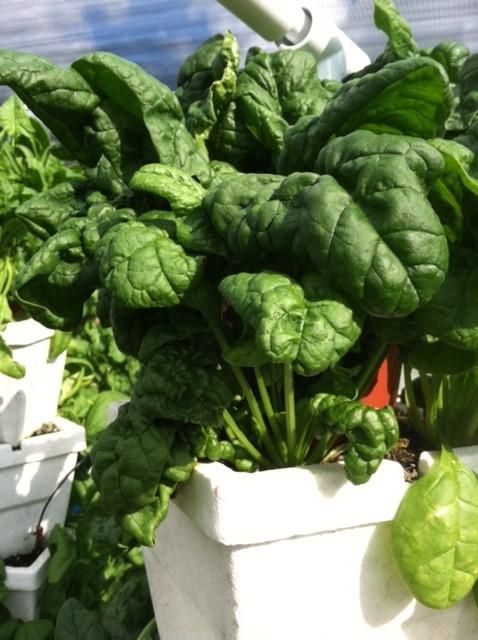
Credit: Natalie Parkell
Brief mention should be made regarding those plants that are commonly referred to as "spinach", but are not members of the Amaranthaceae family. These are the Malabar and New Zealand types of spinach. Unlike the commercially-grown spinach that we eat in the United States (Spinacia oleracea), Malabar and New Zealand spinach plants are tropical, heat-loving varieties. Malabar spinach (Basella rubra) is an Asian vining plant which can reach six feet long or more. The leaves are generally used similarly to Spinacia oleracea in salads and stir-fries. New Zealand spinach (Tetragonia tetragoioides) is a shrubby plant that can spread up to two feet. Both types, while suitable for hot weather cultivation, do not possess the properties of Spinacia oleracea and would most likely find a niche consumer base only in minor direct market outlets.
Swiss Chard
Chard or Swiss chard (Beta vulgaris) is a large, leafy green known also as silver beet, spinach beet, or seakale beet. Also a member of the family Amaranthaceae along with spinach, Beta vulgaris is actually in the same species as beets, but is grown for its leaves rather than its roots. Like spinach, Swiss chard is high in vitamins A, C, and K; minerals; phytonutrients; and dietary fiber. Swiss chard is ranked third for its nutrient density among the PFVs as listed by Di Noia (2014). While the leaves and stems of Swiss chard are all edible, raw or cooked, the leaves are prized most highly and even serve as a substitute for spinach in most recipes.
Swiss chard plants are characterized by large, fleshy, dark green leaves with broad center stalks that can be white, red, orange, yellow, pink, or purple. (Figure 2).
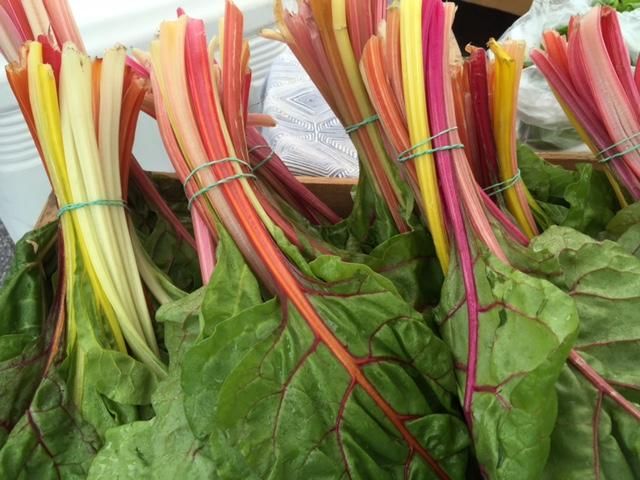
Credit: Natalie Parkell
Because the bulky leaves are easily perishable, Swiss chard does not lend itself well to large commercial production, but rather can be readily found at farmers' markets, where they are directly marketed to end consumers. The propagation of Swiss chard is fairly adaptable to many hydroponic growing systems because it does not generally have the susceptibility to Pythium that spinach does. Additionally, Swiss chard does not have the same cold preference as spinach and thus can be successfully grown nearly year-round in Florida's diverse growing zones.
Kale
In conjunction with the rise in popularity of locally-grown, fresh produce, consumers have been demonstrating a preference for "juicing" or the extraction of liquids/nutrients from raw agricultural products. Kale, one of the top 15 powerhouse vegetables, has been a forerunner in the juicing/smoothie trend. Brassica oleracea L. (Acephala group) which is also known as "borecole," shares the majority of the nutrient profile as the other leafy greens discussed above (Stephens 2012).
As a descendent from wild cabbage in the eastern Mediterranean and Asia Minor, kale's name literally refers to the "cabbage that does not form a head." Leaf colors of this Brassica can range from dark green to blue or with purple or crimson tinges. As a grower faces decisions for crop cultivation, three predominant kale types emerge from the marketplace: 1) curly or Scotch kale, 2) "cavolo nero," black, Lacinato, or Toscano kale, and 3) Siberian kale. The Scotch kales currently predominate the cultivar list available to farmers and are characterized by dark, green leaves with heavily frilled margins that are rather coarse in texture. The savoyed leaf characterizes the Toscano kale category, which is an heirloom type that dates back to the 1800s in the Tuscan region of Europe. This very dark, almost-black, leafed kale is heavily favored by direct marketing outlets, such as restaurant chefs and farmers' markets. The Siberian kales are characterized by nearly flat leaves of variable color, which can have a curled or frilly appearance, but are more tender and have a milder flavor than the other categories (Innvista 2015).
Kale is extremely hardy in many growing zones and, as a result, performs well nearly year-round in Florida. While various cultivars are still sensitive to the increased pressure of disease and insects that accompanies all summertime crops, many kale types can be grown, with appropriate strategies, nearly ten months out of the year, even in the southern zones of the state. Management of kale's robust stems and growth pattern remain the primary challenge for many hydroponic/protected culture systems (Figure 3).
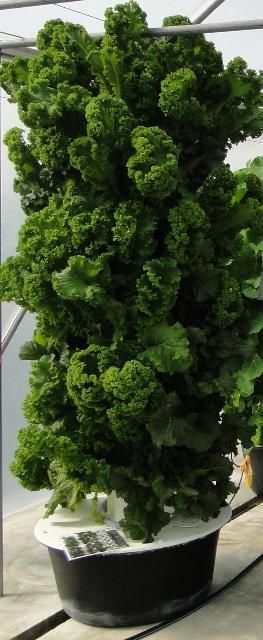
Credit: Wanda Laughlin
Collard Greens
Collards ironically bear the same Latin name as kale, the other "non-heading" cabbage: Brassica oleracea L. (Acephala group). But unlike kale, collards differ in leaf shape, flavor, and traditional cooking methods. A hearty and robust leaf, collard greens thrive over a wide range of growing conditions and can withstand temperatures as low as 15 degrees F, with many consumers even reporting better taste and quality after such cool cycles. The stem of the plant averages nearly three feet tall at maturity, but may actually reach six feet with time. This hardiness lends itself to "cropping" the plant—harvesting the leaves to allow the terminal bud to continue to grow to marketable size. Alternatively, collards may be harvested all at once and including the center stem, requiring a secondary planting for the season.
Regardless of the harvest method, careful consideration must be given in order to accommodate this Brassica's robust growth pattern; not all hydroponic systems will be suitable for production. Growers should consider staking the substantial stems, especially in outdoor systems where weather can damage the leaves. Good crop hygiene is also essential to eliminate dead leaf matter that may accumulate under the plant canopy and increase the likelihood of disease and insect pressure (Figure 4).
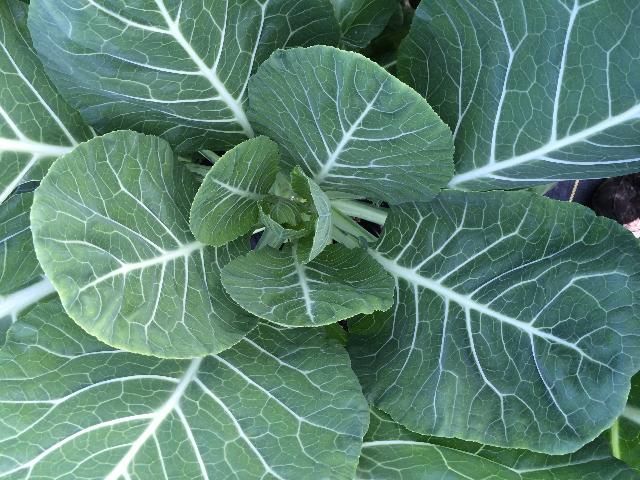
Credit: Natalie Parkell
Mustard Greens
Mustard green leaves, Brassica juncea, are known for their distinctive horseradish, hot and spicy flavor and are widely used in traditional African, Indian, Asian, and African-American cuisines. Grown in a wide array of colors from shades of green to burgundy, this member of the headless cabbage family is prized for its diverse textures, shapes, and growing adaptability. Mustards will succeed in both temperate and subtropical zones, but prefer cooler season temperatures. Susceptible to bolting in summertime or hot greenhouse conditions, mustard greens lend themselves well to the season extension strategies of high tunnels and shade systems.
Mustards that are grown to baby leaf stage or that are harvested before mature/bolting age are a common element in mesclun salad or braising mixes. Some cultures will pickle mustard greens or prepare them in the same manner as collards. Recent market trends have brought raw mustards into the mainstream as a primary cultivar in microgreen production. Mustards' rapid growth (35–40 days to maturity) allows for many successive harvests of tender, milder leaves; whereas dry or hot conditions coupled with excessive nutrients can push the plants to produce more intense peppery flavors (Weller 2005, p. 59). Unlike many of the other larger members of the Brassica family, mustard greens can be widely adapted to multiple hydroponic growing systems (Figure 5).
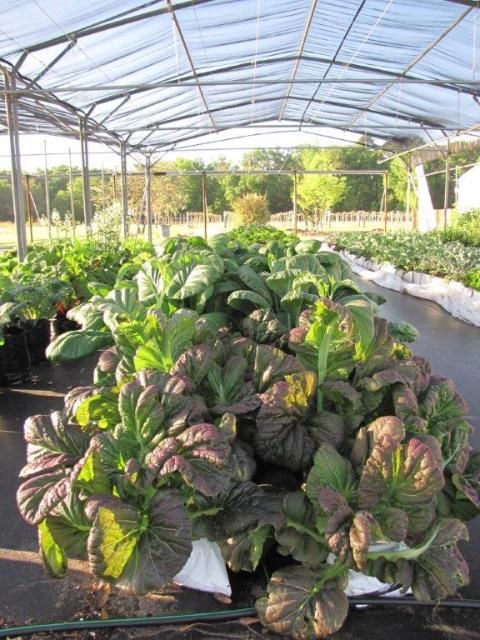
Credit: Wanda Laughlin
Asian Greens
Given the diversity of the Brassicas, several cultivars in the mustard group overlap into a broad category of plants loosely termed Asian greens. The three main groups a grower would likely encounter are found in the Chinese mustard group (Brassica juncea), the turnip group (Brassica rapa), and the cabbage group (Brassica oleracea) (Dawling 2013). These highly nutritious plants run the gamut of culinary roles, shapes, sizes, and leaf characteristics. "Chinese cabbage" is ranked second overall by Di Noia (2014) among powerhouse vegetables for their nutritional composition.
With a great tolerance for both hot and cold growing conditions and relatively rapid growth cycle, these diverse crops lend themselves to virtually all hydroponic production systems. Certain cultivars do produce more robust plants (i.e. 'nappa' or Chinese cabbage) than other compact types (i.e. 'tat soi' or spoon cabbage), but considering the diverse varieties and the mainstream acceptance in direct marketing venues, this category presents itself as an important niche for any hydroponic/protected system grower (Figure 6).
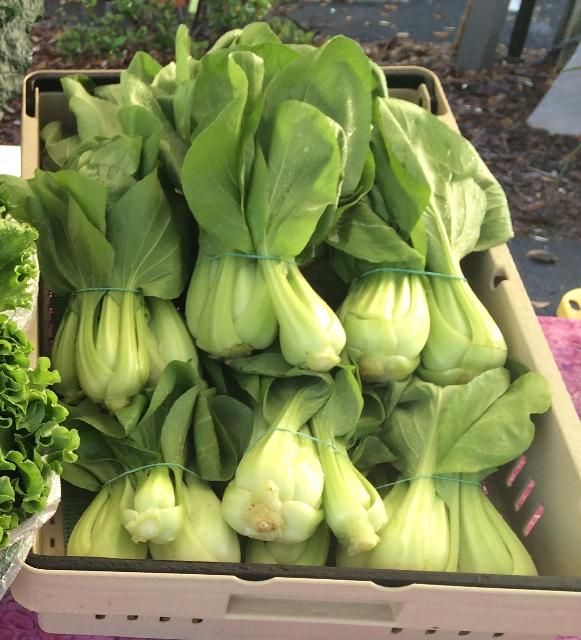
Credit: Natalie Parkell
References
Brechner, M. and D. deVilliers. 2012 A Handbook for the Production of CEA-grown Hydroponic Spinach. Cornell Controlled Environment Agriculture (CEA). Cornell University. http://www.cornellcea.com/attachments/Cornell%20CEA%20baby%20spinach%20handbook.pdf
Dawling, P. 2015. "Producing Asian Greens." Twin Oaks Community. www.slideshare.net/SustainableMarketFarming/producing-asian-greens-2015. (Retrieved September 2015).
Di Noia, J. 2014. "Defining Powerhouse Fruits and Vegetables: A Nutrient Density Approach." Preventing Chronic Disease. 11:130390. DOI: http://dx.doi.org/10.5888/pcd11.130390
Innvista.com. "Kale." www.innvista.com/health/foods/vegetables/kale/. (Retrieved May 2015).
Roman, R. 2012. "Raising Spinach in Florida Takes a Watchful Eye." Highlands Today Agri-Leader. December 5, 2012.
Stephens, J.M. 2012. Kale—Brassica oleracea L. (Acephala group). HS617. Gainesville: University of Florida Institute of Food and Agricultural Sciences. https://edis.ifas.ufl.edu/mv084
Vallad, G.E., J.H. Freeman, and P.J. Dittmar. eds. 2014. Vegetable and Small Fruit Production Handbook of Florida. CV292. Gainesville: University of Florida Institute of Food and Agricultural Sciences. https://edis.ifas.ufl.edu/cv292
Weller, T. 2005. The Best of the Growing Edge International (Volume 3) 2000–2005: Select Cream-of-the-Crop Articles for Soilless Growers. Corvallis, OR. New Moon Publishing.